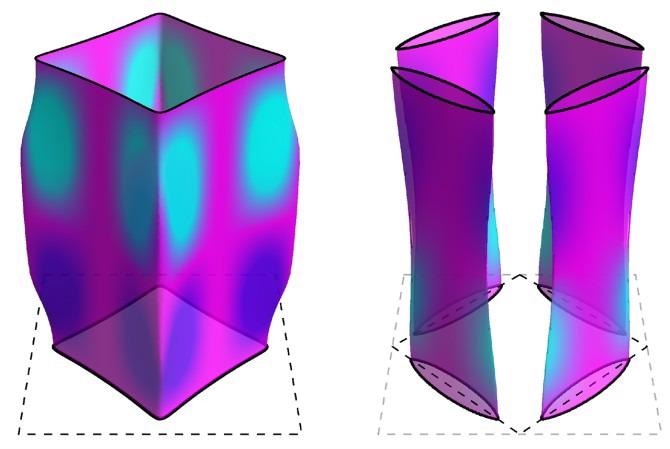Superconductors are metals that enable electricity to travel without resistance and, according to Cornell University physicist Brad Ramshaw, hold promise as the defining material of the near future.

The Fermi surface on the left shows the arrangement of electrons in a copper-oxide high-temperature superconductor before the “critical point.” After the critical point, the Fermi surface on the right shows that most electrons vanish. Research by Brad Ramshaw’s lab connects this disappearance with magnetism. Image Credit: Cornell University.
These metals are already used in drug discovery research, medical imaging machines and quantum computers being engineered by IBM and Google.
However, the extremely low temperatures that traditional superconductors need to operate — a few degrees over absolute zero — make them too expensive for extensive use.
In their hunt to discover more suitable superconductors, Ramshaw, the Dick and Dale Reis Johnson Assistant Professor of physics in the College of Arts and Sciences, and colleagues have learned that magnetism is critical to comprehending the performance of electrons in “high-temperature” superconductors.
With this discovery, they have solved a three-decade-old mystery circling this group of superconductors, which operate at much higher temperatures, beyond 100 degrees above absolute zero.
Their findings have been published in Nature Physics in the March 10th issue.
“We’d like to understand what makes these high-temperature superconductors work and engineer that property into some other material that is easier to adopt in technologies,” Ramshaw explained.
A fundamental mystery to high-temperature superconductors is what takes place with their electrons, Ramshaw stated.
“All metals have electrons, and when a metal becomes a superconductor, the electrons pair up with each other,” he said. “We measure something called the ‘Fermi surface,’ which you can think of as a map showing where all the electrons are in a metal.”
To examine the way electrons pair up in high-temperature superconductors, scientists continuously alter the number of electrons via a method called chemical doping. At a specific “critical point” in high-temperature superconductors, electrons seem to disappear from the Fermi surface area, Ramshaw said.
The team focused on this vital point to work out what makes the electrons disappear, and where the electrons go. They used the 45-tesla hybrid magnet, the world’s most robust steady-state magnet, at the National High Magnetic Field Laboratory in Tallahassee, Florida, to assess the Fermi surface of a copper-oxide high-temperature superconductor as a function of electron concentration, close to the critical point.
They learned that the Fermi surface totally alters as scientists go beyond the critical point.
It’s as if you were looking at a real map and all of a sudden most of the continents just disappeared. That’s what we found happens to the Fermi surface of high-temperature superconductors at the critical point—most of the electrons in a particular region, a particular part of the map, vanish.
Brad Ramshaw, Physicist and Dick and Dale Reis Johnson Assistant Professor of Physics, College of Arts and Sciences, Cornell University
It was crucial for the scientists to observe not just that electrons were disappearing, but which ones specifically, Ramshaw states.
They design various simulation models based on many theories and examined whether they could clarify the data, said Yawen Fang, a doctoral student in physics and the study’s lead author.
In the end, we have a winning model, which is the one associated with magnetism. We are stepping confidently from the well-understood side of the material, benchmarking our technique, into the mysterious side past the critical point.
Yawen Fang, Study Lead Author and Doctoral Student in Physics, Cornell University
Now that they are aware of which electrons disappear, the team has an idea why, and it relates to magnetism.
There have always been hints that magnetism and superconductivity are related in high-temperature superconductors, and our work shows that this magnetism seems to appear right at the critical point and gobble up most of the electrons. This critical point also marks the electron concentration where the superconductivity happens at the highest temperatures, and higher-temperature superconductors are the goal here.
Brad Ramshaw, Physicist and Dick and Dale Reis Johnson Assistant Professor of Physics, College of Arts and Sciences, Cornell University
Being aware that the critical point is related to magnetism provides insight into why these specific superconductors possess such high transition temperatures, Ramshaw remarked, and perhaps even where to search to discover new ones with even greater transition temperatures.
It is a 30-year-old debate that precedes our study, and we came up with a straightforward answer.
Gaël Grissonnanche, Study Co-First Author and Postdoctoral Fellow, Kavli Institute for Nanoscale Science, Cornell University
This study was partly supported by the National Science Foundation, the Kavli Institute for Nanoscale Science at Cornell University, and the Canadian Institute for Advanced Research Azrieli Global Scholars Program.
Journal Reference:
Fang, Y., et al. (2022) Fermi Surface Transformation at the Pseudogap Critical Point of a Cuprate Superconductor. Nature Physics. doi.org/10.1038/s41567-022-01514-1.